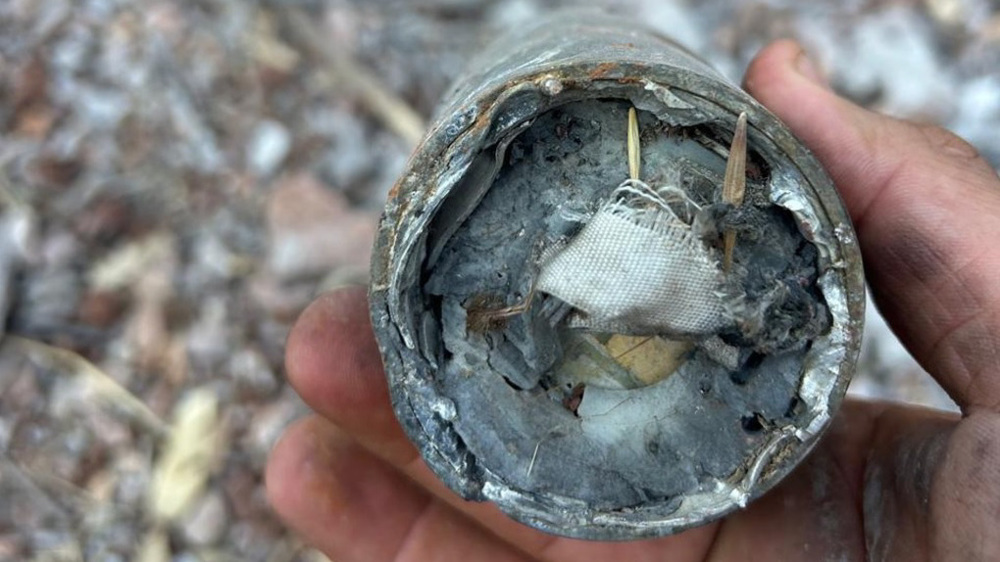A new report has revealed that the Israeli military widely employed cluster munitions, which are outlawed under international law, during its over 14 months of aggression against Lebanon, extensively destroying and damaging civilian structures in the southern part of the country.
The report, published by British daily newspaper The Guardian, cites photos of munition remnants found in southern Lebanon.
The images, which have been examined by six different arms experts, appear to show the remnants of two different types of Israeli cluster munitions – the 155mm M999 Barak Eitan and 227mm Ra’am Eitan guided missiles.
The M999 Barak Eitan is an advanced anti-personnel cluster round produced by major Israeli weapons manufacturer Elbit Systems in 2019. Each M999 artillery shell disperses nine submunitions that explode into 1,200 tungsten fragments.
Israeli media have described the Ra’am Eitan as a guided missile carrying 64 submunitions that spread over a wide area and kill anyone within it.
According to an Israeli army press statement issued in February 2024, Israeli forces deployed along the border between the northern part of the occupied territories and Lebanon had been equipped with Ra’am Eitan missiles in preparation for fighting Hezbollah resistance fighters.
The Israeli cluster munitions were found in three locations in southern Lebanon, where Israeli bombing has been most deadly, namely the forested valleys of Wadi Zibqin, Wadi Barghouz, and Wadi Deir Siryan.
The evidence marks the first indication that Israel has deployed cluster munitions since the 33-day war on Lebanon in 2006, and it would also be the first time the usurping regime is known to have used the two newer types identified.
Cluster munitions are a type of bomb designed to disperse numerous smaller submunitions, commonly referred to as bomblets, across a broad area comparable to the size of several football fields.
Cluster munitions are widely prohibited due to their high failure rate, with up to 40% of submunitions failing to detonate on impact. This leaves civilians at risk, as these unexploded devices can later detonate and cause fatal injuries to those who encounter them.
As of now, 124 states have become part of the Convention on Cluster Munitions, prohibiting their use, production, and transfer. However, Israel has not joined the convention.
“We believe the use of cluster munitions is always in conflict with a military’s duty to respect international humanitarian law because of their indiscriminate nature at the time of use and afterwards,” Tamar Gabelnick, the director of the Cluster Munition Coalition, said.
Their wide area impact, she added, means they cannot distinguish between military and civilian targets and the cluster munition remnants kill and maim civilians for decades after use.
During the 2006 war, Israel dropped four million cluster bombs on Lebanon in the final days before a ceasefire was reached. An estimated one million unexploded bomblets remained, killing 400 people since that time.
Human rights organisations argue that it is impossible to use cluster munitions in any way that significantly minimises harm to civilians.
“Cluster munitions are banned internationally for a reason. Their use is inherently indiscriminate, there is no lawful or responsible way to deploy them, and civilians bear the greatest burden because these weapons remain deadly for decades,” Brian Castner, head of crisis research at Amnesty International, said.
Israel and Hezbollah reached a ceasefire agreement that took effect on November 27, 2024. Under the deal, Tel Aviv was required to withdraw fully from the Lebanese territory—but has kept forces stationed at five sites, in clear violation of UN Security Council Resolution 1701 and the terms of last November’s agreement.
Since the implementation of the ceasefire, Israel has violated the agreement multiple times through repeated assaults on the Lebanese territory.
Lebanese authorities have warned that the Israeli regime’s violations of the ceasefire threaten national stability.
IMAGE CREDIT: Remnants found of a cluster munition in southern Lebanon show a white nylon ribbon, used to stabilize and spin submunitions. Photo> PRESS TV
[ SOURCE: PRESS TV and NEWS AGENCIES ]

